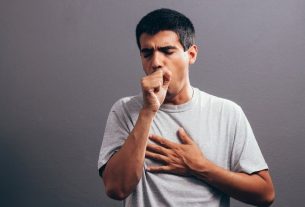Phlegm in the throat can appear due to low water intake during the day, or because the air is drier, which can leave the throat dry and irritated, with thicker mucus. However, it can also happen due to health conditions such as tonsillitis, pharyngitis, sinusitis or even gastroesophageal reflux.
Depending on its cause, phlegm in the throat may be accompanied by other symptoms, such as a feeling of phlegm stuck in the throat, constant phlegm, sore throat, cough, fever or yellow or greenish phlegm, for example. See what each color of phlegm means.
It is recommended that an otorhinolaryngologist or general practitioner be consulted whenever symptoms of phlegm appear in the throat, especially if it worsens quickly or is accompanied by other symptoms, so that the cause can be diagnosed and the most appropriate treatment can be initiated. with analgesics, anti-inflammatories, and in some cases, antibiotics.

The main causes of phlegm in the throat are:
1. Drink little water
Drinking little water during the day can make the throat drier and increase the viscosity of the mucus in the throat, since water is part of the composition of phlegm, which can result in the feeling of phlegm stuck in the throat or constant phlegm.
What to do: The ideal is to keep your throat hydrated, drinking at least 2 liters of water a day in small sips, to help thin the phlegm and relieve the feeling of phlegm stuck in the throat. For people who have difficulty drinking water, a good option is to add the juice of half a lemon to the water to add flavor and make it easier to drink.
2. Dry air and air conditioning
When the air is drier, the mucous membrane of the nose and throat tends to lose moisture, and the throat tends to become more irritated, and the mucus becomes thicker, leading to the sensation of constant phlegm in the throat or phlegm stuck in the throat, in addition to dry cough, throat clearing or even hoarseness.
Furthermore, using air conditioning can also make the air in the room drier, favoring throat irritation and constant phlegm.
What to do: The ideal is to avoid air conditioning and exposure to dry environments. In addition, it is recommended to drink plenty of water and apply mucous membrane hydration solutions, such as saline solution, to the nose. Another measure is to use a room humidifier, as it increases air humidity, reducing throat irritation or inflammation, in addition to opening the airways and helping to release phlegm. See how to use the humidifier correctly.
3. Sinusitis
Sinusitis is an inflammation of the nasal sinuses, which are small cavities in the skull, around the nose and eyes, generally caused by allergic diseases or infections by viruses, fungi or bacteria, causing phlegm to accumulate in the nose.
Excess phlegm in the nose can lead to post-nasal drip, which is when phlegm drips down the throat, causing coughing, swelling, throat irritation, and a scratchy sensation in the throat and yellow or greenish phlegm in the throat.
What to do: The treatment of sinusitis is generally carried out with medicines recommended by the otorhinolaryngologist, such as analgesics, anti-inflammatories, nasal decongestants or antibiotics. Furthermore, to complement medical treatment, you can do nasal washing with water and salt or saline solution, or steam inhalations to help fluidify the phlegm, helping to eliminate it and relieving symptoms. See the main remedies for sinusitis.
4. Cold and flu
The flu and cold are infections caused by viruses, which can enter through the nose and reach the throat mucosa, leading to symptoms such as inflammation or irritation in the throat, white or gray phlegm, sore throat, cough, fever, sneezing, headache and body pain.
What to do: You should keep your body hydrated, drinking plenty of fluids and resting. Additionally, the otorhinolaryngologist may recommend the use of analgesic, anti-inflammatory or decongestant medications, such as paracetamol, ibuprofen or desloratadine, for example, to help alleviate symptoms. Learn how to differentiate the flu from a cold.
5. Bacterial tonsillitis
The presence of phlegm in the throat can also be caused by bacterial tonsillitis, which is an inflammation of the tonsils, which are structures located in the throat, caused by bacteria, mainly Streptococcus pyogenes.
Furthermore, other symptoms that may appear are phlegm with pus, intense sore throat, difficulty swallowing, high fever or the presence of pus in the throat.
What to do: The treatment of bacterial tonsillitis must be carried out under the guidance of an otorhinolaryngologist who may recommend the use of antibiotics to combat the infection, such as amoxicillin, azithromycin, clindamycin or cephalosporin, for example. Check out the main treatments for bacterial tonsillitis.
6. Allergic rhinitis
Allergic rhinitis is an inflammation of the mucous membrane of the nose that can lead to the accumulation of phlegm in the nose, which in excess can drip into the throat, causing a feeling of constant phlegm in the throat, in addition to a blocked or runny nose, watery eyes and constant sneezing.
Allergic rhinitis is caused by contact with allergenic substances, such as dust, pollen, animal dander or some plants, for example, and may be more frequent during spring or autumn.
What to do: The treatment of allergic rhinitis must be guided by an allergist or general practitioner, according to the intensity and frequency of symptoms, and the use of anti-allergic medications may be indicated, such as desloratadine or cetirizine, for example, in addition to being essential to avoid contact with the substance that caused allergy. See the main anti-allergens that may be recommended by your doctor.
7. Pharyngitis
Pharyngitis is an inflammation of the pharynx, located at the back of the throat, which can be caused by viruses, such as adenovirus, rhinovirus or influenza, or bacteria, such as Streptococcus pyogenesfor example, causing a sore throat, difficulty swallowing and a scratchy or itchy sensation in the throat, and green or yellow phlegm in the throat.
Furthermore, in some cases fever, headache, general malaise and hoarseness may appear.
What to do: The treatment of pharyngitis varies according to the symptoms and the cause, and the otorhinolaryngologist may recommend the use of analgesics, anti-inflammatories, or antibiotics. Furthermore, it is important to rest and drink plenty of fluids during treatment. Check out the main treatments for pharyngitis.
8. Gastroesophageal reflux
Gastroesophageal reflux is the return of stomach contents towards the mouth, causing pain, an unpleasant taste and, in some cases, an itchy throat and a feeling of constant phlegm in the throat, due to the irritation caused by the acidic contents of the stomach.
What to do: gastroesophageal reflux should be treated as recommended by the gastroenterologist with the use of antacids, gastric protectors or gastric emptying accelerators, to prevent the return of stomach acid to the mouth, relieving symptoms. Check out the main remedies for gastroesophageal reflux.
9. Exposure to irritants
Exposure to irritating substances, such as cigarette smoke or pollution, can cause throat irritation and chronic inflammation, which leads to increased production and accumulation of phlegm in the throat.
Furthermore, other symptoms that may arise are a scratchy, itchy throat or even a sore throat.
What to do: Avoiding exposure to substances that cause throat irritation is the most effective measure. If this is not possible, you can use calming tablets that have honey, lemon or ginger in their composition, or gargle with solutions based on water and salt.
In the case of smoking, you should consult your general practitioner who can recommend measures to stop smoking or medications, such as bupropion or varenicline. See the main remedies to stop smoking.
10. Lung problems
Some lung problems, such as bronchitis, asthma or pneumonia, can cause increased mucus production in the lungs, nasal congestion and coughing with clear, white, yellowish-gray or green phlegm, which may also contain blood.
Furthermore, these respiratory problems can cause pain or irritation in the throat, a feeling of constant phlegm in the throat, as well as other symptoms such as difficulty breathing or shortness of breath, wheezing when breathing, fever or excessive tiredness.
What to do: You should consult a pulmonologist who can indicate the most appropriate treatment that varies according to the lung problem, and the use of medications such as corticosteroids or inhaled bronchodilators, in the form of firecrackers, analgesics, anti-inflammatories, expectorant syrups or mucolytics may be indicated. , and, in some cases, antibiotics. See how bronchitis, asthma and pneumonia are treated.
11. Use of nasal decongestants
The use of nasal decongestants, in the form of solutions or nasal spray containing substances that cause a narrowing of blood vessels in the nasal mucosa, such as naphazoline or pseudoephedrine, can lead to increased production of mucus in the nose, which can drip into the throat and cause the sensation of phlegm in the throat.
This is because when using nasal decongestants excessively or for a prolonged period of time, rebound nasal congestion may appear, which is when the body starts to produce substances to cause dilation of the blood vessels in the nasal mucosa, as it perceives that there has been a decrease in blood flow in that region. and thus the discomfort of nasal congestion may worsen.
What to do: Nasal decongestants should only be used if recommended by the doctor and for the shortest possible treatment time, which generally varies from 3 to 7 days, depending on the substance present in the decongestant.

Sign up for our newsletter and stay up to date with exclusive news
that can transform your routine!
Warning: Undefined array key "title" in /home/storelat/public_html/wp-content/plugins/link-whisper-premium/templates/frontend/related-posts.php on line 12
Warning: Undefined array key "title_tag" in /home/storelat/public_html/wp-content/plugins/link-whisper-premium/templates/frontend/related-posts.php on line 13




